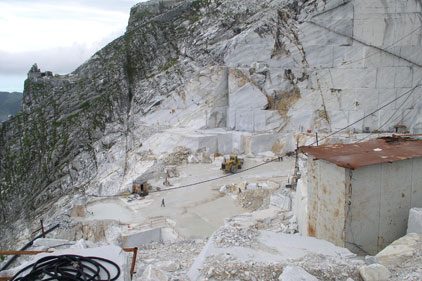"We have brought the results out earlier than usual this year because the situation is particularly complex, and we want companies -- as well as associations and institutions -- to be in a position to make their own assessments of such a difficult year as 2011 by accessing this information, which also contains indications for reflection for 2012," explained Giorgio Bianchini, IMM Chairman. "To do this we have looked both at the trends underway and managerial solutions in the belief that all contributions are useful."
The overall analysis showed that while the recession certainly played a factor in 2011 for many Italian companies, confidence may be increasing for 2012.
Nationwide, 22% of Italian stone-related companies declared an increase in their sales, while companies in the Apuo-Versilian (Carrara) district a much higher percentage declared an increase in all the sectors taken into consideration. The machinery and technology sector in the district, in particular, showed signs of recovery -- as almost half the companies said sales increased compared to 2010.
This can in part be attributed to the popularity of marble from the Carrara region, particularly the white varieties, which are extremely popular in the U.S. market at the present time.
Overall, foreign demand remained stable despite the fact that the unstable situation in North Africa had a negative impact on exports in marble blocks and slabs.
Future investments
In terms of investments, the economic crisis heavily affected company investments in 2011 with a negative balance for all sectors. The Apuo-Versilian district, however, seems to have cut back on investments the least, with 20% of companies declaring that they increased their investments -- compared to 14% in the rest of Italy.
The companies interviewed were asked specifically about their plans to invest in 2012, and they showed a strong intention to invest in the future.
Plans on employment in the industry were stable, but not overly optimistic. A total of 80% of companies will keep the same number of workers in 2012, and 18% of those interviewed employed at least one new person in 2011, whether temporary or permanent. The most active sector was the machinery and technology sector, where every company took on an average of one new worker. The outlook for 2012, though, does not seem as positive in terms of a growth in employment, as 80% of companies interviewed said they did not intend to change the number of employees.
Continuing innovation
Speaking on the topic of innovation, a total of 63% of companies said they had introduced at least one product, service or process innovation in the three-year period from 2009 to 2011. Some may have been at zero cost, yet the percentage is considered to be encouraging considering the difficult economic situation.
The sectors more inclined to make innovation are the machinery, technology and related industries, where approximately 80% of companies introduced at least one new feature.
Companies in the Apuo-Versilian district proved, however, to be the least inclined to invest compared to the rest of Italy -- as is shown by the average spending in research and development, which tends to be lower.
Possible reduction in production?
The most difficult question concerned companies' forecasts for production over the first six months of 2012. The responses substantially show pessimism both in terms of production figures for the industry as a whole and the individual companies. Once again the Apuo-Versilian district tends to be less pessimistic compared to the rest of the country, with around 44% of machinery and technology companies foreseeing an increase in production compared to around just 24% for those that foresee a reduction.
The complete research report is available at www.immcarrara.com






